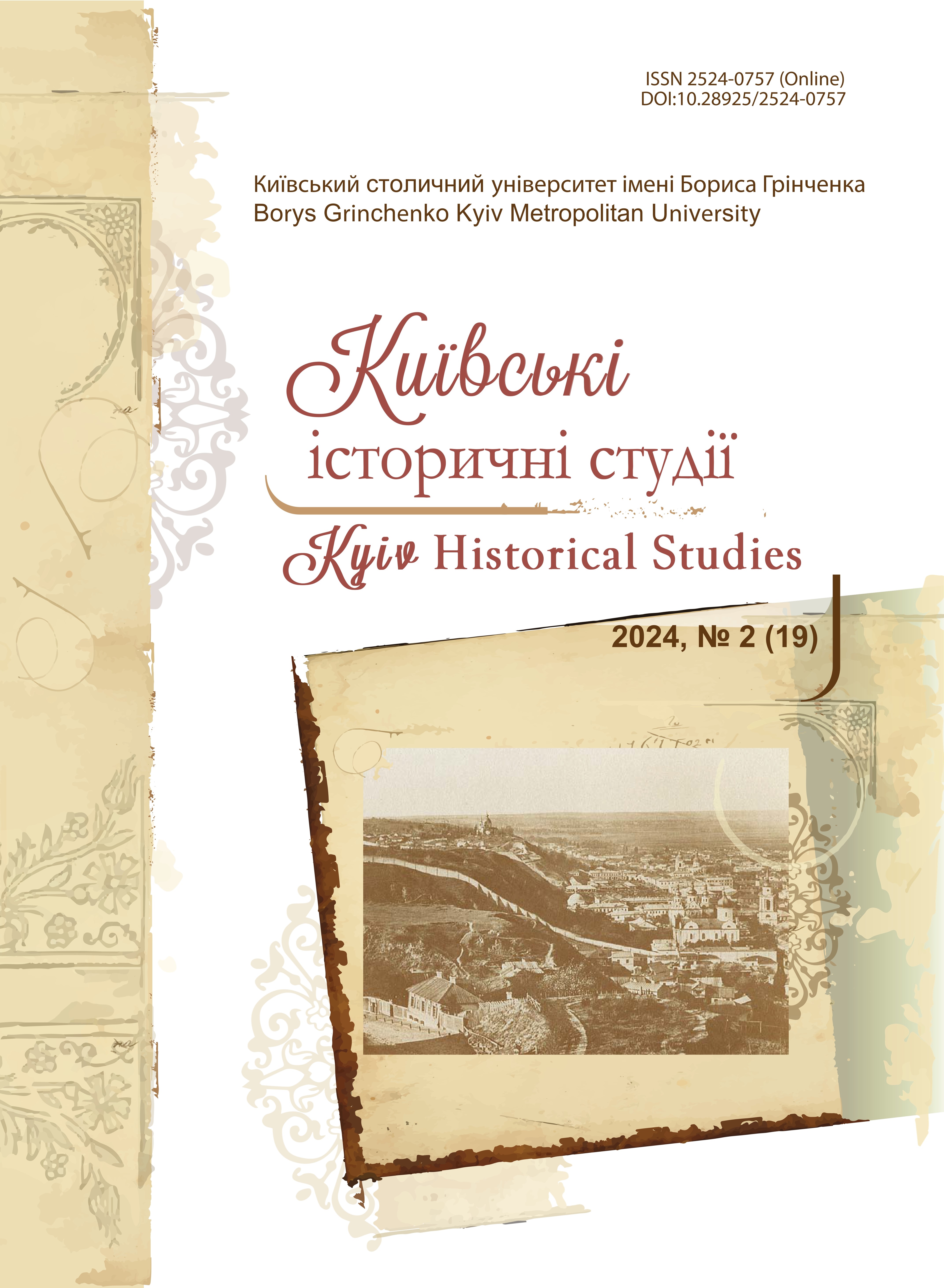Volhynian Provenance of the Radziwill Chronicle: Hypothesis and Its Critical Assessment
DOI:
https://doi.org/10.28925/2524-0757.2024.216Keywords:
Radziwill chronicle, miniatures, marginalia, chronicle-writing, Volhynia, Grand Duchy of LithuaniaAbstract
The Radziwill chronicle is a unique Cyrillic manuscript dating back to the late 15th century. It was named after Radziwill princely family who kept it in the mid-17th century. The chronicle covers historical period from the mythical beginnings of Rus’ land up to the early 13th century. But it is not unique in terms of its text which is well-studied by scholars. Its exclusivity lies in over 600 miniatures that were once called “windows on a lost world”. In fact, the Radziwill chronicle is a copy of the illuminated codex of the early 13th century though its miniatures underwent some changes in the West-European style. Since the times of Aleksey Shakhmatov it is generally believed that the Radziwill chronicle was compiled in the city of Smolensk which was the part of the Grand Duchy of Lithuania up to 1514. This notion is mostly based on the results of linguistic analysis of the chronicle as the manuscript itself lacks any indications on the place of its creation. The concept of chronicle’s Smolensk origin is so engrained in academic literature that there were even proposals to rename it to the Smolensk chronicle. But after almost a century of scholarly consensus regarding this issue the new concept emerged. It was put forward in 2004 by Russian researcher Andrey Nikitin in whose opinion the Radziwill chronicle was compiled in the bishop’s scriptorium in Volodymyr (Volhynia). The theory formulated by Nikitin found its ardent supporter in Ukraine. The view of Volodymyr as chronicle’s hometown was enthusiastically accepted by Oleksiy Tolochko who promoted this theory in a number of publications. His conclusions were based on some paintings and marginal notes of the Radziwill chronicle. Unfortunately, his ideas have never been critically assessed despite being quite a novelty for chronicle studies. This served as an impetus for detailed examination of his “Volhynian theory”. As it appeared, it lacks any scholarly value and thus should be completely ignored.
Downloads
References
Artamonov, M. I. (1931). Miniatiury Kenigsbergskogo spiska letopisi. Izvestiia Gosudarstvennoi akademii istorii materialnoi kultury, (10/1), 1–28 [in Russian].
Artcikhovskii, A. V. (2004). Drevnerusskie miniatiury kak istoricheskii istochnik. Tomsk; Moscow [in Russian].
Augustyniak, U. (2014). Testamenty ewangelików reformowanych w Wielkim Księstwie Litewskim w XVI–XVIII wieku. Warszawa [in Polish].
Bobrov, A. G. (2017). Kitovras Efrosina Belozerskogo. Trudy Otdela drevnerusskoi literatury, (65), 423–449 [in Russian].
Chernetsov, A. V. (1981). K izucheniiu Radzivilovskoi letopisi. Trudy Otdela drevnerusskoi literatury, (36), 274–288 [in Russian].
Danilevskii, I. N. (1995). Zamysel i nazvanie Povesti vremennykh let. Otechestvennaia istoriia, 5, 101–110 [in Russian].
Danilevskii, I. (2013). Miniatiury Radzivilovskoi letopisi: problemy prochteniia. Blgarska Ukrainistika, (3), 188–197 [in Russian].
Filiushkin, A. (2002). Istoriia s tochki zreniia zdravogo smasla? Ukrainskyi humanitarnyi ohliad, (7), 39–50 [in Russian].
Gantssov, V. N. (1927). Osobennosti yazyka Radzivillovskogo (Kenigsbergskogo) spiska letopisi. Izvestiia Otdeleniia russkogo iazyka i slovesnosti imp. Akademii nauk, (32), 177–242 [in Russian].
Gorskii, A. A. (2001). «Vsego esi ispolnena zemlia russkaia…». Moscow [in Russian].
Ilin, V. V. (1992). Smolensk — slovo starinnoie i charuiushchee. Smolensk [in Russian].
Kiersnowski, R. (1991). «Akademia Smorgońska» i jej legenda. In: Kultura średniowieczna i staropolska (595–603). Warszawa [in Polish].
Kondakov, N. (1902). Zametka o miniatiurakh Kenigsbergskogo spiska nachalnoi letopisi. In: Radzivilovskaia ili Kenigsbergskaia letopis. T. 2: Stati o tekste i miniatiurakh rukopisi (115–127). Saint-Peterburg [in Russian].
Kosiakova, V. (2018). Apokalipsis Srednevekovia: Ieronim Boskh, Ivan Groznyi, Konets sveta. Moscow [in Russian].
Kukushkina, M. V. (1996). K voprosu o meste proiskhozhdeniia Radzivilovskoi letopisi v spiske XV v. Trudy Otdela drevnerusskoi literatury, (50), 374–383 [in Russian].
Kushch, T. V. (2019). Knizhnaia kultura zapadnoyevropeiskogo Srednevekovia. Ekaterinburg [in Russian].
Likhachiov, D. S. (1986). Protiv diletantizma v izuchenii «Slova o polku Igoreve». In: Issledovaniia «Slova o polku Igoreve» (183–196). Leningrad [in Russian].
Miliaieva, L. (2014). Dumky i sposterezhennia shchodo ikony Yerusalymskoi Bohomateri. Volynska ikona: doslidzhennia ta restavratsiia, (21), 10–18 [in Ukrainian].
Nevostruev, K. (1868). Slovo sv. Ippolita ob antikhriste v slavianskom perevode po spisku XII v. Moscow [in Russian].
Nikitin, A. L. (2004). O Radzivilovskoi letopisi. Germenevtika drevnerusskoi literatury, (11), 526–557 [in Russian].
Pchiolov, E. V. (2011). Bestiarii Moskovskogo tsarstva: zhivotnyie v emblematike Moskovskoi Rusi kontsa XV — XVII vv. Moscow [in Russian].
Petrushko, L. (2022). Neradisni emotsii v miniatiurakh i teksti Radzyvillivskoho litopysu. Tekst i obraz: aktualni problemy istorii mystetsva, (14/2), 52–61 [in Ukrainian].
Podobedova, O. I. (1965). Miniatiury russkikh istoricheskikh rukopisei: K istorii russkogo litsevogo letopisaniia. Moscow [in Russian].
Rybakov, B. A. (1984). Iz istorii kultury drevnei Rusi: Issledovaniia i zametki. Moscow [in Russian].
Rybakov, B. A. (1994). Miniatiury Radzivilovskoi letopisi i russkie litsevye rukopisi X–XII vv. In: Radzivilovskaia letopis. Kn. 2: Tekst. Issledovanie. Opisanie miniatiur (280–301). Saint-Peterburg; Moscow [in Russian].
Sazonov, S. V. (1995). Smekhovye motivy v miniatiurakh Radzivilovskoi letopisi. In: Istoriia i kultura Rostovskoi zemli (35–40). Rostov [in Russian].
Sazonov, S. V. (1997). K atributsii odnoi iz miniatiur Radzivilovskoi letopisi. In: U istochnika (263–281). Moscow [in Russian].
Shakhmatov, A. A. (1913). Zametka o meste sostavleniia Radzivilovskogo (Kenigsbergskogo) spiska letopisi. In: Sbornik v chest 70-letiia professora D. N. Anuchina (69–75). Moscow [in Russian].
Shchavinskaia, L. L. (1998). Literaturnaia kultura belorusov Podliashia XV–XIX vv. Minsk [in Russian].
Shchavinskaia, L. L. (1998). Vilniusskii voevoda Yanush Radzivill – chitatel kirillicheskikh rukopisei. Senoji Lietuvos literatūra, (6), 248–253 [in Russian].
Shchelchkova, T. A. (2008). «Radzivilovskaia» ili «Smolenskaia» letopis? Izvestiia Smolenskogo gosudarstvennogo un-ta: Istoricheskie nauki, (4), 174–179 [in Russian].
Simonov, R. A., Turilov, A. A., & Chernetsov, A. V. (1994). Drevnerusskaia knizhnost. Moscow [in Russian].
Sizov, V. I. (1905). Miniatiury Kenigsbergskoi letopisi. Izvestiia Otdeleniia russkogo yazyka i slovesnosti imp. Akademii nauk, (10/1), 1–50 [in Russian].
Soloviova, I. D. (1989). Knizhnik i ikonopisets Efrem — sovremennik Efrosina. Trudy Otdela drevnerusskoi literatury, (42), 268–279 [in Russian].
Staviskii, V. I. (2015). O vozmozhnom istochnike nekotorykh obrazov letopisnoi «Pokhvaly» kniaziu Romanu Mstislavichu. Slovĕne, 2, 159–179 [in Russian].
Svirin, A. N. (1964). Iskusstvo knigi Drevnei Rusi XI–XVII vv. Moscow [in Russian].
Temushev, S. N. (2015). Dan v miniatiurakh Radzivilovskoi letopisi. Drevniaia Rus: Voprosy medievistiki, 2, 5–22 [in Russian].
Tolochko, A. (2005). Pririsovki zverei k miniatiuram Radzivilovskoi letopisi i problema proiskhozhdeniia rukopisi. Ruthenica, 4, 62–84 [in Russian].
Vasilik, V. (2013). Eskhatologicheskie predstavleniia v Galitcko-Volynskoi letopisi. Rusin, 1, 136–148 [in Russian].
Vishnia, I. B. (2021). Miniatiury Radzivilovskoi letopisi: avtorskaia manera i kolichestvo masterov. Peterburgskii istoricheskii zhurnal, 2, 189–204 [in Russian].
Yurganov, A. L. (1998). Kategorii russkoi srednevekovoi kultury. Moscow [in Russian].
Published
How to Cite
Issue
Section
License
Copyright (c) 2024 Олена Русина

This work is licensed under a Creative Commons Attribution-NonCommercial-ShareAlike 4.0 International License.
Authors who publish in this journal retain the right of authorship of the work and give to the journal right of first publication of this work under the conditions of Creative Commons: Attribution-NonCommercial-ShareAlike 4.0 International (CC BY-NC-SA 4.0), which allows others freely distribute the work published with reference to the authors of the original work and the first publication of this magazine.














